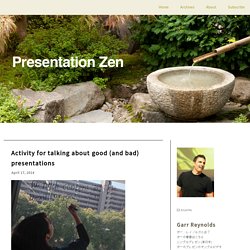

How to make a good (or bad) presentation. This semester I'm teaching three classes on presentation for undergraduates at my university in Japan.

On the second day, I have students share with the class what they think are the elements of a good presentation and what they think are the kinds of things that make for a bad or ineffective presentation. Students may still be quite young, but they have sat through years of classes in school and lectures in college, sat through orientation meetings, and they have seen many kinds of presentations online such as TED talks over the years, so students actually do have quite a bit of experience with various kinds of presentations. I use a slide like this or just write something similiar on the whiteboard. "Think about the best and the worst presentations you have ever seen. What's the difference? ActivityFor the activity I ask students to break up into groups of 4-5 to share their ideas—based on their experience—on what makes for a good presentation and what makes for a bad presentation.
Design Strategy. Six Drucker Questions that Simplify a Complex Age - Rick Wartzman. By Rick Wartzman | 3:00 PM November 6, 2013 In 1981, Peter Drucker delivered a lecture at New York University titled “Managing the Increasing Complexity of Large Organizations.”

Drawing on lessons from the auto industry, banking and beyond, he offered provocative prescriptions for coping in a world in which “the real challenge is to decide what you are doing” in the face of tremendous “technological change or market change.” But, as was his wont, Drucker didn’t just provide answers. Speaking slowly, through his thick Viennese accent, he asked questions: “How do we organize the new within the old?”
“How do you organize your entrepreneurial within the managerial?” This was no mere rhetorical device. With that in mind, here are six questions—all of them straight out of Drucker’s writing—that I believe he would now pose to any manager trying to cope with, in his words, “the complexities of size, markets, products and technologies.” 1. 2. 3. 4. 5. 6. The Art of Crafting a 15-Word Strategy Statement - Alessandro Di Fiore. By Alessandro Di Fiore | 12:00 PM February 12, 2014 In the January issue of HBR, Roger Martin sets out some rules for avoiding common mistakes in strategy making.

As he writes in “The Big Lie of Strategic Planning”, the first rule is “keep the strategy statement simple.” Rather than a long, often vague document, the company’s strategy should summarize the chosen target customers and the value proposition in one page. I couldn’t agree more. In my consulting work, I take this idea even further by asking my clients to summarize their strategy in less than 15 words. Focus: What you want to offer to the target customer and what you don’t;Difference: Why your value proposition is divergent from competitive alternatives.
Sounds simple. All great business strategies can be summarized in a short headline. Neuroscience can help us in this endeavor. To understand the power of comparison, let me retell this famous old advertising story. Is Your Innovation Problem Really a Strategy Problem? - Tim Kastelle. By Tim Kastelle | 10:00 AM February 11, 2014 Sometimes, the problem that we think we’re solving isn’t the real problem that we face.

I was running a workshop with a multinational engineering firm when I ran into a perfect example of an air sandwich, which illustrates this point. This dangerous obstacle to innovation is described by Nilofer Merchant in The New How as “the empty void in an organization between the high-level strategy conjured up in the stratosphere and the realization of that vision down on the ground.” The firm is facing some challenges. Much of the work in their industry is becoming commoditized, and their margins have been shrinking. They have responded to these changes in their competitive environment and have started to position themselves as the most innovative firm in their market. And yet the potential rewards are also significant. This is a fairly typical profile of innovation capability within a large firm. The senior team is delusional.
Strategy in a World of Constant Change - Roger Martin. By Roger Martin | 1:00 PM February 3, 2014 Am I the only person to be getting a bit weary of hearing it repeatedly asserted that we’re living in a world of constant, accelerating change?

That competitive advantages are becoming ever more transient and that the secret to survival will be to the ability to transform on a dime? Otherwise, what happened to Tom Tom will happen to you. Please! Let me share a fun clip with you, sent to me the other day my former colleague Jonathan Rotenberg, founder of the Boston Computer Society. The moment I loved most was during the Q&A when an older gentleman asked Jobs a challenging question about the mouse as user interface technology: did it really compare favorably to the traditional keystroke approach?
The really interesting thing about the gentleman’s question was the fact that it was asked 19 years after the mouse was shown to be a definitively superior graphical user interface at Xerox PARC in 1965. Advantage is neither transitory nor immortal.